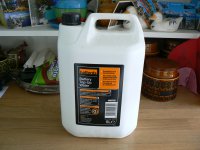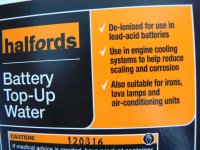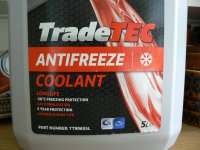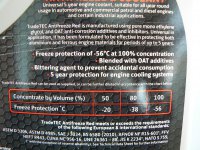Does it have to be distilled water? Haynes manual doesn't mention anything about distilled water, and saw Scotty Kilmer flushing his Toyota coolant system with just his outside tap.
Flushing through with tap water is how I do it. I then use De-ionised water to mix up a 50/50 mix with the antifreeze concentrate. In fact up here in Edinburgh our tap water is super soft. We get no scaling problems in kettles etc and a lovely soapy foam in the shower. Unlike my daughter down in Wiltshire who has to virtually take a hammer and chisel to her kettle! For many years I just used tap water and have never had a problem (it would be a different story in a hard water area i'm sure). But, getting older and wiser and more of a "worrier" I started using the de-ionised water after seeing it on the shelf one day.
I buy the de-ionised water from Halfords (currently £3.50 for 5 litres and you get a good discount with their Trade Card - if you can get one. This is how it comes:

I particularly like that it reassuringly tells me it's for use in cooling systems:

Someone on our forum was, some time ago, suggesting that de-ionised water is not ideal for this use as it can "leach back" ions from the metal of the engine. I don't know about the risk in this, and have read other accounts elsewhere which say it's not a factor worth worrying about. I have been using it for many years now. It was in my older boy's Fabia, my Cordoba (owned for nearly 19 years, Both our Fiats - Punto and Panda, and I've topped up my younger boy's Astra with it (reminds me that one needs a flush and refill). The Ibiza and Rio are too young to require attention yet, The only one I'm shying away from is the Jazz. It has blue antifreeze but Honda say it's organic technology. This worries me because "blue" antifreeze has always meant to me it's "silicate" whereas "red" is usually OAT (Organic Acid Technology) The two do not mix. As OAT is generally considered to be much superior (and only needs changing every 5 years) I use OAT now a days. So, until I get round to draining flushing and refilling with the "red" stuff, I'll be buying a litre bottle - at an exorbitant price - from the Honda garage for topping up.
As far as the actual antifreeze itself goes I always check the manufacturer's spec and then see if my factor can supply. For many years I have used Comma's products with out any problems as that was the volume brand stocked by my friend at his factors. Now that ill health has sadly caused his business to close down I'm using TradeTEC products as that's what my new supplier stocks:

I've no idea what all the technical bumph at the bottom of the label is but this TradeTEC RED is what his computer recommends and all seems fine so far:

I don't believe in mixing any antifreeze so, as with the FIATs, when changing brand I would always completely flush out and then only top up with the same product. I know most manufacturers say that as long as you stick with the correct spec you can top up with a different brand but it always niggles away at me that there might be a subsequent diminution in the effectiveness of the additives?

